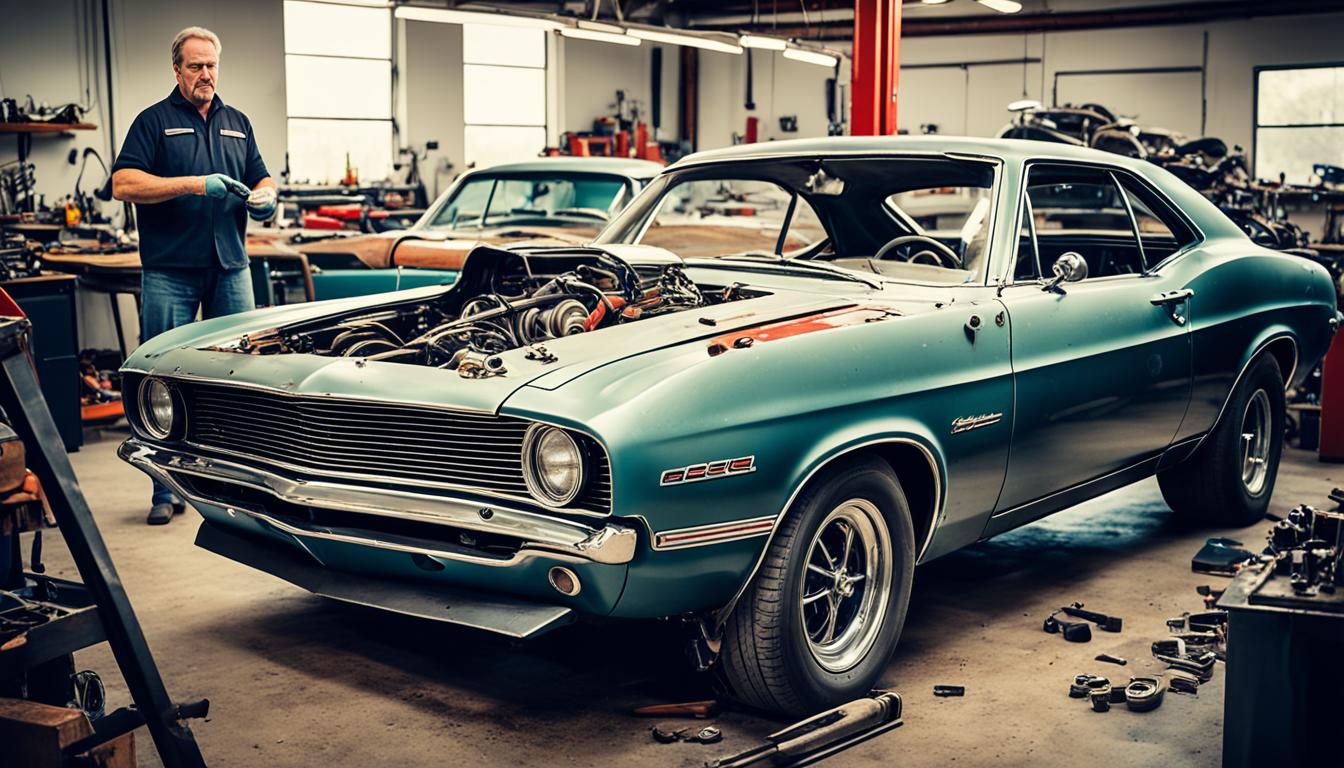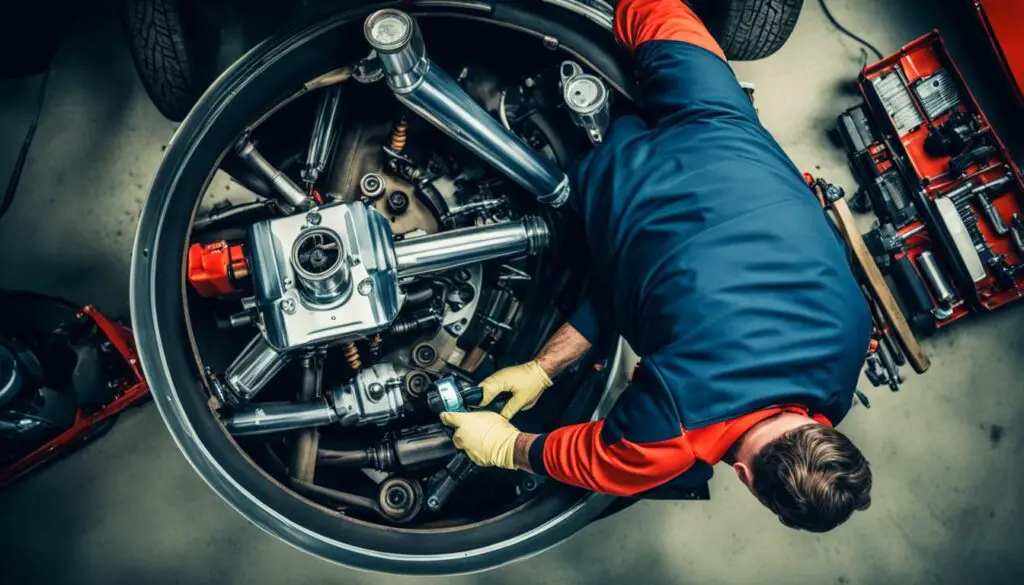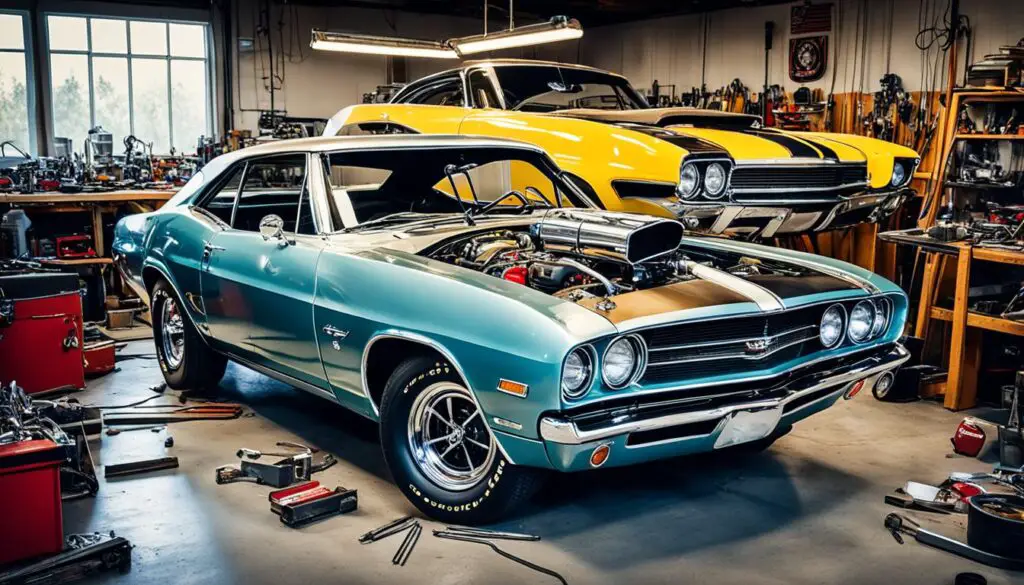
Muscle Up Your Car: Essential Muscle Car Restoration Tips
Restoring a muscle car can be incredibly fulfilling. It lets you craft your dream car, saves money, and you can do it your way. Experts say you can save $15,000 to $20,000 by doing it yourself.
Key Takeaways:
- Restoring a muscle car yourself can save you a significant amount of money compared to hiring professionals.
- Building your car allows you to customize it exactly how you want it.
- A full restoration can result in savings of $15,000 to $20,000 in labor costs.
Factors to Consider in Muscle Car Restoration
Before you start restoring a muscle car, think about a few key things. Planning and reviewing are crucial for a successful outcome. Focus on important factors like budget, extent of restoration, and your technical skills.
Budget: Restoring on a Realistic Scale
It’s key to set a budget for your project. Figure out how much you can spend, including parts and tools. A clear budget helps prevent you from overspending. It also makes your restoration smoother.
Extent of Restoration: Set Your Goals
Decide if you’re aiming for a full restoration or focusing on specific parts. It’s crucial to match your goals with your car’s condition. This approach will help you set up a manageable timeline.
Technical Abilities: Know Your Limits
Assess your mechanical skills honestly. This helps you decide which tasks you can do yourself. It’s okay to get help if needed. Recognizing your limits saves time and stress.
DIY Muscle Car Restoration: Embrace the Challenge
Restoring a muscle car is a big project that can be very rewarding. It requires hard work and a love for cars. Research your car model extensively. Exchange tips with other enthusiasts online.
“Restoring a muscle car is a labor of love that requires patience, persistence, and a genuine passion for the craft.” – Jake Thompson, Classic Car Restoration Expert
Bartering for Restoration Services: Tap into Collaborative Networks
If you’re not an expert in every task, consider bartering. This means exchanging skills or goods for needed services. Bartering helps you get the job done without going over budget. It also connects you with a community of fellow car lovers.
Vehicle Inspection: Assessing the Project Scope
Before you start, carefully check your car for issues. Look for damage, rust, and other problems. Make a detailed plan based on your inspection. This step is crucial for a smooth restoration process.
Thinking about these factors before you start will prepare you well. This helps you tackle the project steps confidently and enjoy the results more.

Top Tips for a Successful Muscle Car Restoration
When restoring a muscle car, every detail counts. This includes the bodywork and engine. Each part plays a big role in making your classic car a standout. These tips will help your restoration go smoothly:
- Muscle Car Bodywork: Begin by looking closely at your car’s bodywork. Find parts that need fixing, like rusted areas or broken frames. You should get advice from a bodywork pro and choose top-notch materials for the best result.
- Engine Restoration: Your muscle car’s heart needs to shine as well. Take apart, clean, and put back your engine. It’s vital to use real, fitting engine parts. Don’t forget about the gaskets and seals to help your engine work its best.
- Interior Restoration: The inside should be as charming as the outside. You can either restore what’s there or get new parts. Think about adding old-style knobs and switches to create a classic feel.
- Paint Preparation: A perfect paint job starts with great prep work. Clean your car well, removing old paint or rust. Then, use a top-quality primer. Finally, pick a color that was popular back when your car was made.
- Original Engine Parts: It’s smart to use real engine parts if you can. They not only keep the car true to its history but also help it perform and hold its value. Look for trusted dealers who have preserved these parts well.
- Simple Interior Restoration: If you’re watching your budget, you can still make the inside look great. Carefully clean and keep up the original upholstery and dashboard without making too many changes.
Don’t forget to keep track of your work with photos and notes. This will not just be a great memory but also a useful guide for future jobs or if you decide to sell.
Restoring a muscle car is a journey back in time, uncovering its beauty and power. Enjoy the work, aim for high quality, and soon you’ll be driving your dream. Happy restoring!
Recommended Muscle Car Restoration Suppliers
| Supplier | Specialty |
|---|---|
| Classic Industries | Wide range of restoration parts and accessories |
| National Parts Depot | Large inventory of original and reproduction parts |
| YearOne | High-quality restoration parts for various muscle car models |
| Legendary Auto Interiors | Premium reproduction upholstery and interior components |
| Eastwood | Specialized restoration tools, paints, and coatings |

Conclusion
Restoring muscle cars is fulfilling and fun. It lets you customize your ride and keep its vintage allure. You’ll need to think about the budget, how deep you want to restore, your mechanical skill, and the parts you use. With careful planning, you can turn your ideal muscle car into reality.
Don’t forget to have fun and mark every milestone. Starting the engine again, or seeing your car freshly painted, are big deals. They show how much effort you put in.
Working on a muscle car isn’t just a hobby. It’s a way to honor its rich history and turn it into a masterpiece. So, get ready to work hard, use your tools, and start this amazing journey. Your perfect muscle car is just waiting for you.
FAQ
What is muscle car restoration?
Muscle car restoration is all about bringing a classic muscle car back to life. Mechanics often rebuild them completely. This can mean making them look just like they did when they were new. Or, changing them up to fit someone’s personal style.
How much does muscle car restoration cost?
The price for fixing up a muscle car varies. It depends on how much work it needs and what you want it to look like. On average, this can cost between ,000 and ,000.
Can I restore a muscle car myself?
Absolutely, you can do it yourself. It’s a big job but very rewarding. Doing it yourself means you’re in charge and you can save money too.
What are some essential muscle car restoration tips?
For a great restoration:
1. Plan everything carefully, including your budget.
2. Know what you can do technically.
3. Check every inch of the car.
4. Find the best parts for your car.
5. Be patient and do things step by step.
6. Don’t be afraid to ask for help.
7. Have fun and celebrate each achievement along the way.
Where can I find muscle car restoration parts?
You can look for parts online, at special car part stores, in junkyards, and at car events. These are all good places to start.
Do I need special tools for muscle car restoration?
You’ll need a good set of basic tools. Some jobs will need special tools. You can usually rent or borrow these types of tools.
How long does muscle car restoration take?
The time it takes to fix a muscle car varies. It depends on the condition of the car and how you want it to turn out. This project can last from a few months to a few years. It’s all about your commitment and the resources you have.
